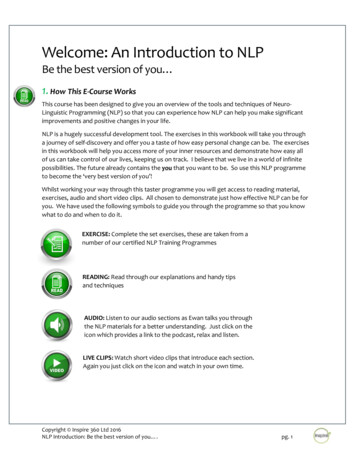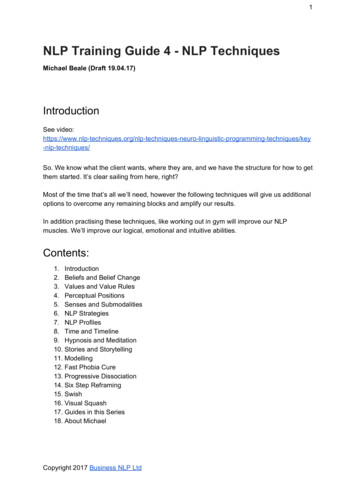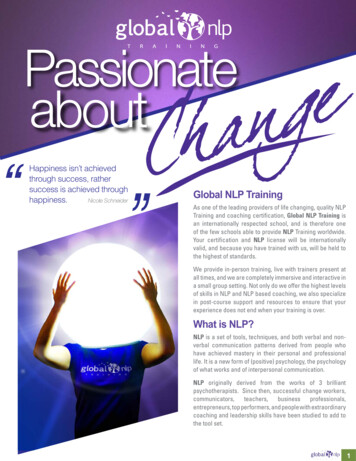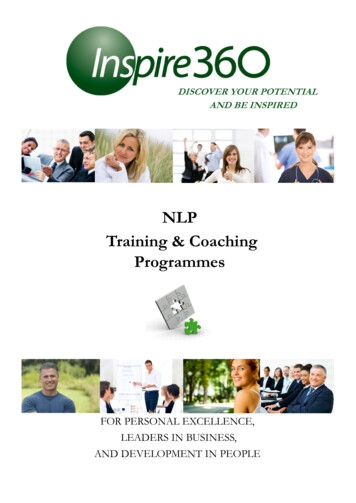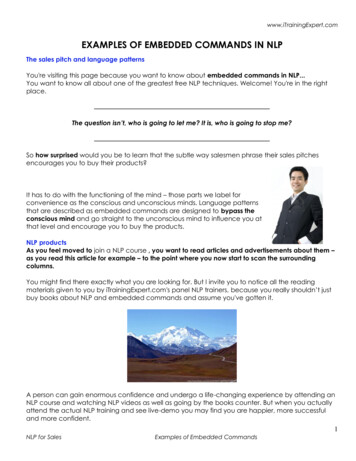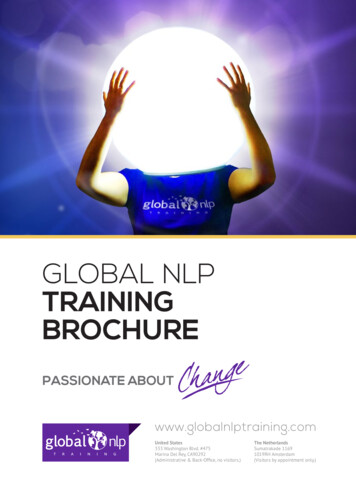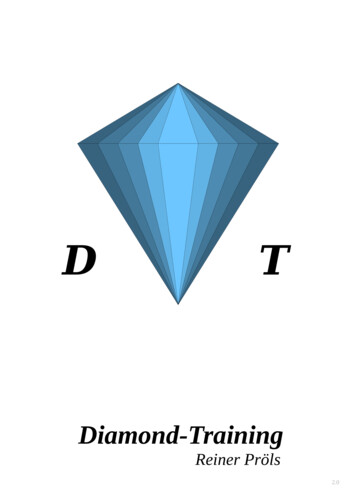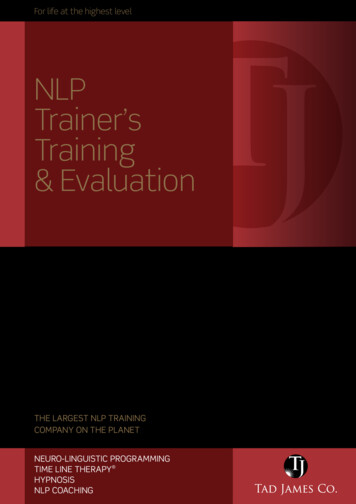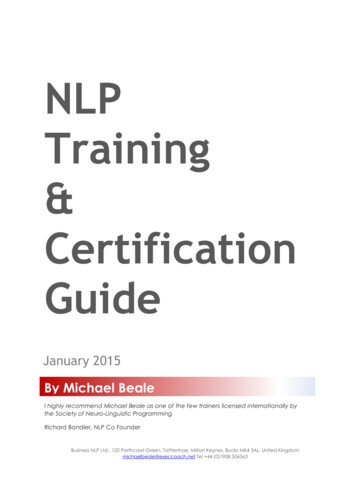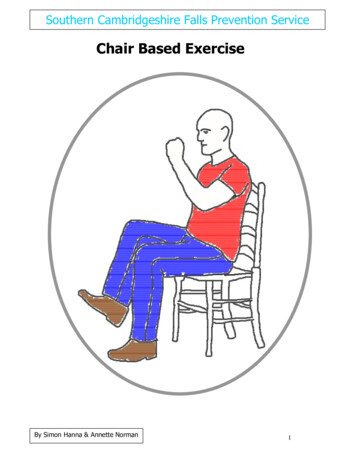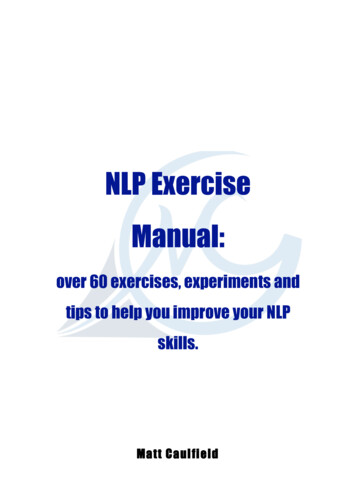
Transcription
NLP ExerciseManual:over 60 exercises, experiments andtips to help you improve your NLPskills.Matt Caulfield
2009 Matt CaulfieldThis entire document is copyright to Matt Caulfield. No part of this bookletmay be reproduced or transmitted in any form by any means, electronic,mechanical, photocopying, recording or otherwise, without express and priorwritten consent of the author. Copyright 2009 Matt Caulfield1www.mattcaulfield.com
ContentsIntroduction.03Calibration Exercises.05Hypnotic Language and the Milton Model.11Chunking. 21The Meta Model. 23Submodalities and Anchors.35Time, Timelines, Temporal Predicates.42Strategies. 49Meta Programmes.58Exercise List.61Appendix I – Glossary of Grammatical Terms.65Appendix II – The Presuppositions of NLP. 66Appendix III – Practitioner Level Certification Skill Requirements. 67Appendix IV – Master Practitioner Level Certification Skill Requirements. Copyright 2009 Matt Caulfield268www.mattcaulfield.com
Introduction Copyright 2009 Matt Caulfield3www.mattcaulfield.com
NLP is a practical subject, it is not something to be read about, or listened toor watched, it is something that you DO. It was born out of curiosity andexploration. This is still the best way to learn the attitude, methodology andtechniques of NLP.With that in mind I have gathered together in this eManual a wide variety ofdifferent exercises to help you explore and improve your NLP skills. I havebroken them down as much as I can into different areas of the syllabus, butbe careful to remember that NLP is holistic, just because you are practicingtimelines does not mean you can switch off your sensory acuity, you rapportskills or anything else!These are the very same exercises I use on my NLP trainings and workshops,as well as in the practice groups I have run and the work with one to oneclients (in a mentoring role). I have also used a lot of the exercises myself toimprove my skills (and still do).Some are designed to have a specific outcome; others are moreexperimental, do the exercise and see what happens. They are not designedto be done in any order and you can dip in and out as you need to or fancy.There are suggested group sizes for each exercise, but these are not set instone. The exercises can be adapted to do just by yourself, and where groupsof 2 are suggested, it is often a good idea to add a 3rd person as an observerto give feedback to the people doing the exercise.I have also included a list of the Presuppositions of NLP as laid down by itscreator Dr Richard Bandler, a glossary of grammatical terms (so many peopleI work with and train go into a cold sweat when asked to define a “verb”!) andthe syllabus requirements for Practitioner and Master Practitioner qualificationthrough the Society of NLP, the first and largest NLP certification, training,validation and quality control organisation in the world. Copyright 2009 Matt Caulfield4www.mattcaulfield.com
Calibration Exercises Copyright 2009 Matt Caulfield5www.mattcaulfield.com
1. Calibrating to the Visual Rep SystemGroups of 21. B thinks of someone they like. A watches and calibrates. A can helpget B in state by guiding them with language such as “Think ofsomeone you really like, think of the most fun time you have had withthat person. Go back to that time now. See what you saw, hear whatyou heard, feel what you felt.” (for A to do this successfully it isimportant that they “go there first”, i.e., get in state whilst thinking ofsome they like).2. B thinks of someone they don't like (A assists with getting them instate). A watches and calibrates.3. Without telling A, B thinks of one or the other. A judges which one B isthinking of by comparing the visual cues.1. Repeat until A has got it correct 3 times.4. Switch roles. Copyright 2009 Matt Caulfield6www.mattcaulfield.com
2. Calibrating to the Auditory Rep SystemGroups of 22. A and B sit back-to-back.3. B counts to ten out loud while thinking of someone they like. A listensand calibrates.4. B counts to ten out loud while thinking of someone they don't like. Alistens and calibrates.5. Without telling A, B thinks of one or the other. A judges which one B isthinking of by comparing auditory cues.6. Repeat until A has got it correct 3 times.7. Switch roles.3. Calibrating to the Kinesthetic Rep SystemGroups of 21. A and B touch hands palm to palm, eyes closed.2. B thinks of someone they like. A calibrates to the feeling.3. B thinks of someone they don't like. A calibrates to the feeling.4. Without telling A, B thinks of one or the other. A judges which one B isthinking of by comparing kinesthetic cues.5. Repeat until A has got it correct 3 times.6. Switch roles. Copyright 2009 Matt Caulfield7www.mattcaulfield.com
4. Calibrating to BreathingGroups of 21. Face each other.2. A extends arm straight out and puts hand on B's shoulder.3. As B breathes in and out, A should be able to feel the rise and fall ofB's shoulder.4. As B inhales, A raises hand, when B exhales A lowers hand.5. Calibrating Different PeopleGroup of 4 or 51. A thinks of 2 people. To assist in the changing of the state B anchorseach person on a different place (make sure to follow good anchorprotocol: Break state between setting anchors, repeat until get strongresponse, etc)2. B fires off each anchor to have A go back and forth (breaking state inbetween) several times.3. C, D and E notice the differences.4. B asks person A comparative questions, e.g.: Which person lives closer to you? Which person is taller? etc5. A thinks the answer of the question, but does not say it out loud. C, Dand E judges which person A is thinking of. Copyright 2009 Matt Caulfield8www.mattcaulfield.com
6. Calibrating to Non-Verbal ResponsesGroups of 21. A asks B “Yes” or “No” question. B responds verbally “Yes” or “No”. Acalibrates the non-verbal cues provided along with the verbalresponses.2. A asks B “Yes” or “No” question. B responds by thinking of the answerwithout giving a verbal response.3. A judges which response is offered (“Yes” or “No”).7. The Pencil ExerciseGroups of 2.1. A holds a pencil or pen by one end, letting it hang down.2. B places thumb and forefinger on either side of the pencil, about twoinches apart.3. A drops the pencil and B attempts to catch it before it falls out of reach.4. B looks for the cues that A is exhibiting as he decides to drop thepencil. The accessing cues of the submodality changes for A’s decisionare observed by B in A’s face, etc. Copyright 2009 Matt Caulfield9www.mattcaulfield.com
8. The Coin GuessGroups of 21. A takes a coin and places it behind their back, places it in either theright or left hand brings their hands out in front of them2. B judges which hand A is holding the coin is in by looking for cues andtells. Copyright 2009 Matt Caulfield10www.mattcaulfield.com
Hypnotic Language and theMilton Model Copyright 2009 Matt Caulfield11www.mattcaulfield.com
9. Representational Systems and Linkage WordsGroups of 51. A generates a sentence using a VISUAL predicate and adds a linkageword e.g. "I can see the shadows on the wall AND.”2. B completes sentence using a VISUAL predicate e.g., ".they fade andflicker WHILE.”3. Once all the group have had a turn, repeat cycle using AUDITORYpredicates.4. Then repeat cycle using KINESTHETIC predicates.Note: It is important that the person continuing the round does not repeat theconjunction “and” each time.10. Sensory Predicates and Linkage words1. A generates 2 sentences using 2 predicates in differentrepresentational systems and 2 conjunctions, e.g. "I saw a car ANDheard its engine running WHILE. . . "2. Cycle through group using different predicates.Note: It is important that the person continuing the round does not repeat theconjunction and continues the sentence in a different representational system. Copyright 2009 Matt Caulfield12www.mattcaulfield.com
11. Causal ModellingGroups of 4 or 51. A states (as a statement of what the other person can hear) averifiable experience (something they can see, hear, feel, smell, ortaste) and links it to something they want to happen, e.g. “You arelistening to the sound of the traffic outside AND you find you arebeginning to relax, WHILE.”2. B continues sentence3. Work through until everyone in the group has had a go.12. Presupposition DrillsCan be done in a group or individually.Part 1Generate 10 examples of each of the Milton Model Presupposition Patterns:1. Subordinate clause of time2. Ordinal numbers3. Use of “or”4. Awareness predicates (see exercise above)5. Adverbs and adjectives6. Changes of Time adverbs and adjectives7. Commentary adverbs and adjectives Copyright 2009 Matt Caulfield13www.mattcaulfield.com
Part 21. Decide on something you want to persuade someone to do.2. Generate at least 10 examples of each Milton Model Presuppositionpattern, with your outcome mind.3. Combine and organise in to a paragraph.4. If in a group, read your paragraph and get feedback.13. Time PresuppositionsGroup of 3Design 3 sentences with 3 time presuppositions of each tense thatpresuppose the acceptance of an idea: Past eg. yesterday, did, had Present eg. today, have, now Future eg. tomorrow, shall, might14. Presuppositions - SpatialGroup of 3Put together 3 sentences using space presuppositions which presuppose theacceptance of an idea to include: Location eg. this, that, here, there, etc. Functional Relationship eg. above/below, in/out, on/off, Measurement eg. more/less, some/few. Copyright 2009 Matt Caulfield14www.mattcaulfield.com
15. Tonal PresuppositionsGroups of 4 or 51. A chooses 3 states. Says same sentence in each different state.2. The group look for distinctions between each state without your tellingthem what each state was, just from your tonality shifts.16. Tonal Presuppositions - Eliciting ResponsesGroup of 2A says the word below in several different tones (depending on state, egangry tone, relaxed tone) to elicit different responses in B: Only Please MoreNotice state changes16. Presuppositions: Varying the Position of “Only”Groups of 2A varies the position of the word “only” in the sentence. Elicit B’ssubmodalities for each to see the state change for each statement:1. Only I can tell you the way to do this now.2. I can only tell you the way to do this now.3. I can tell only you the way to do this now.4. I can tell you the only way to do this now.5. I can tell you the way to only do this now.6. I can tell you the way to do only this now7. I can tell you the way to do this only now. Copyright 2009 Matt Caulfield15www.mattcaulfield.com
17. “Artfully Vague” Pattern DrillsCan be done in a group or individuallyPart 11. Generate 10 sentences using Nominalisations.2. Generate 10 sentences using Unspecified verbs.3. Generate 10 sentences using Unspecified Referential Index.4. Generate 10 sentences using Deletions.Part 25. Decide on something you want to describe.6. Generate at least 10 examples of each Milton Model patterns, with youroutcome mind.7. Combine and organise in to a paragraph (being “artfully vague”).8. If in a group, read your paragraph and get feedback about what theyimagines, what was in too much detail, what jarred, etc. Copyright 2009 Matt Caulfield16www.mattcaulfield.com
18. Indirect Elicitation Pattern DrillsCan be done in a group or individuallyPart 11. Generate 10 sentences using Embedded Questions.2. Generate 10 sentences that can be Analogue Marked.3. Generate 10 sentences using Embedded Commands.4. Generate 10 sentences using Negative Commands.5. Generate 10 Conversation Postulates.Part 21. Decide on something you want to persuade someone to do.2. Generate at least 10 examples of each Milton Model pattern, with youroutcome mind.3. Combine and organise in to a paragraph.4. If in group, read your paragraph and get feedback Copyright 2009 Matt Caulfield17www.mattcaulfield.com
19. Ambiguity DrillsCan be done in a group or individuallyPart 11. Generate 10 sentences using Phonological Ambiguity.2. Generate 10 sentences using Syntactic Ambiguity.3. Generate 10 sentences using Scope Ambiguity.4. Generate 10 sentences using Punctuation Ambiguity.Part 21. Generate at least 10 examples of each Ambiguity pattern, with youroutcome mind.2. Combine and organise in to a paragraph.3. If in group, read your paragraph and get feedback Copyright 2009 Matt Caulfield18www.mattcaulfield.com
20. Trance Induction Language (Calibrating and Leading)Groups of 21. Listen to the tempo of your partners voice.2. Notice the rhythm of their breathing.3. Begin an simple trance induction using the following patterns: Linkage Lack of Referential Index Sentence Fragments4. At a linkage point, use analogue marking (i.e., "and." or "while.").5. Switch roles.21. Pacing/Matching RhythmsGroup of 21. A closes eyes.2. B matches A’s breath movement with rhythm (tap foot).3. B starts to talk in rhythm of A’s breathing4. Notice effect on A.5. Repeat steps 1-4 varying intonation patterns.6. Utilise breath matching and language patterns to induce either a st
NLP is a practical subject, it is not something to be read about, or listened to or watched, it is something that you DO. It was born out of curiosity and exploration. This is still the best way to learn the attitude, methodology and techniques of NLP. With that in mind I have gathered together in this eManual a wide variety of different exercises to help you explore and improve your NLP .
